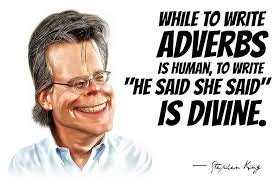 At this point in the game, you probably know what a dialogue tag is. It is a phrase placed at the end of a quote to identify the speaker. It should mimic speech’s natural rhythm and make long dialogue-runs digestible.
At this point in the game, you probably know what a dialogue tag is. It is a phrase placed at the end of a quote to identify the speaker. It should mimic speech’s natural rhythm and make long dialogue-runs digestible.
When using dialogue tags, it is recommended that you keep them simple. There is nothing wrong with the word ‘said’. Don’t give in to the urge to use every big word you know. If you do, you will end up with a big, clunky, mess. The wrong tag can overshadow the words spoken and draw your reader out of the story.
Example:
“You hit my car!” she screamed. “It wasn’t my fault!” he groaned. “But you ran the red light!” She expostulated. “I know-I’m sorry,” he stammered.
Could you imagine reading an entire book written this way? I would go nuts.
This example shows how tags can effect your story by slowing down the pace and overshadowing the dialogue. I was hesitating after every tag and imagining the characters going through the emotions. I couldn’t help myself. And why would anybody use expostulating? Somebody had their thesaurus open 🙂
When you use the words ‘he said’ or ‘she said’, they are so familiar to your reader that they blur into the background and become invisible. This allows the dialogue itself to come to the forefront. You can also drop tags entirely when it’s clear who’s speaking. Overuse of tags can be just as annoying as using the wrong tag.
Example:
- “You hit my car!” she said.
- “It wasn’t my fault!” he said.
- “But you ran the red light!”
- “I know-I’m sorry.”
I hope you thought this example read much smoother than the first. It didn’t distract from what was being said, and you weren’t focusing on the dialogue tags themselves.
There is so much information on dialogue tags. I’m only scratching the surface with this blog.
I’m not saying that you can’t use emotion in a tag, but it is always better to show the character’s emotions through action than it is throwing an adverb into the dialogue tag ( menacingly, shakily, surprisingly…).
While they are only tags, they play an important role in the mechanics of your story and can lead to some major mistakes if not used appropriately.
-Jan R
Good advice. What I need to really work on is to find individual speaking styles so that the character is readily identifiable in my short stories. Still working on it!
LikeLiked by 1 person
Thank you, this is good advice.
LikeLiked by 1 person
Thank you!
LikeLiked by 1 person
I think I agree with Eric Klingenberg. If you only use ‘he said/she said ‘ it gets to sound rather boring and stilted. Just saying. Who am I to argue with better writers.
LikeLiked by 1 person
You can skip dialogue tags altogether by using action. Also if it’s a lengthy conversation, the reader will know who’s talking after a few he said, she saids. Thanks for stopping by 🙂
LikeLike
Reblogged this on Just Mitzi and commented:
Good advice for all writers, editors, and proofreaders. Please read this short, but helpful post.
LikeLiked by 1 person
Thank you!
LikeLike
All good advice. I’ll be sharing. Thank you.
LikeLiked by 1 person
Reblogged this on 🦉Pizzazz Book Promotions.
LikeLiked by 1 person
Thank you!
LikeLike
Reblogged this on Viv Drewa – The Owl Lady.
LikeLiked by 1 person
Thank you!
LikeLike
Reblogged this on The Life & Times of Zoe the Fabulous Feline.
LikeLiked by 1 person
Thank you!
LikeLike
You say you’ve only scratched the surface, Jan, but I’m not sure there is a lot more that can, or needs to, be said on this subject. At any rate, you certainly hit the key points. As an editor, I am always on high alert for overuse, misuse, and every other abuse of dialogue tags. Great post!
LikeLiked by 2 people
Thank you!
LikeLike
I think this is good advice. I’ve found myself adding a few too many he said/she said.
LikeLiked by 1 person
Thank you and thanks for stopping by 🙂
LikeLike
Interesting article but I’m not sure I agree. I much prefer beats to tags, but then each to their own. I also hate cliche so I don’t know why I just did that!
LikeLiked by 1 person
Thanks for sharing and stopping by:-)
LikeLiked by 1 person
Thanks. 🙂 Sharing…
LikeLiked by 1 person
Thanks for stopping by 🙂
LikeLike
Reblogged this on Chris The Story Reading Ape's Blog.
LikeLiked by 1 person
Thanks 🙂
LikeLiked by 1 person
Welcome 😀
LikeLike